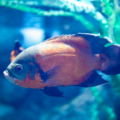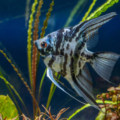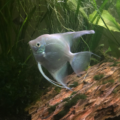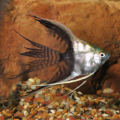Learn why having the spotted Leopard Angelfish in your community tank is a good decision from aquarium management advice and care tips to breeding a healthy pet.

Delving into the World of Leopard Angelfish
Hello, aquarium enthusiast. Welcome to the Leopard Angelfish Overview, where we take a deep dive into the world of this popular exotic aquarium fish.
The Leopard Angelfish earned its spot as one of the most popular ornamental angelfish varieties based on its physical characteristics. Its spotted scales reminds you of the fur of an African wildcat, which has inspired many fashionable trends and is now worthy of beautifying your aquarium waters.
This patterned Angelfish also has a unique coloration and fin structure that allows it to swim gracefully upwards and downwards.
If you’re interested in learning how the Leopard Angelfish captured the hearts of other hobbyists like you and want to join the trend, keep reading.
This comprehensive care guide will show you all the reasons you should add this striking aquarium species to your tank.
Origins and Breeding History
The Leopard Angelfish origins are traced to the Amazon and Orinoco river basins in South America, where they inhabited the warm, murky waters.
Wild Angelfish displayed natural variation in color and pattern, catching the attention of early breeders who employed selective breeding to highlight this distinctive feature.
During breeding, breeders isolated fish with pronounced patterns as breeding pairs and exploited science to advance the genetic development of this fish.
Over time, the Angelfish has evolved into a stunning example of calculated aquarium beauty. Its distinctive spotted pattern and vibrant colors make it a go-to for exotic fish breeding.
Distinguishing Physical Features
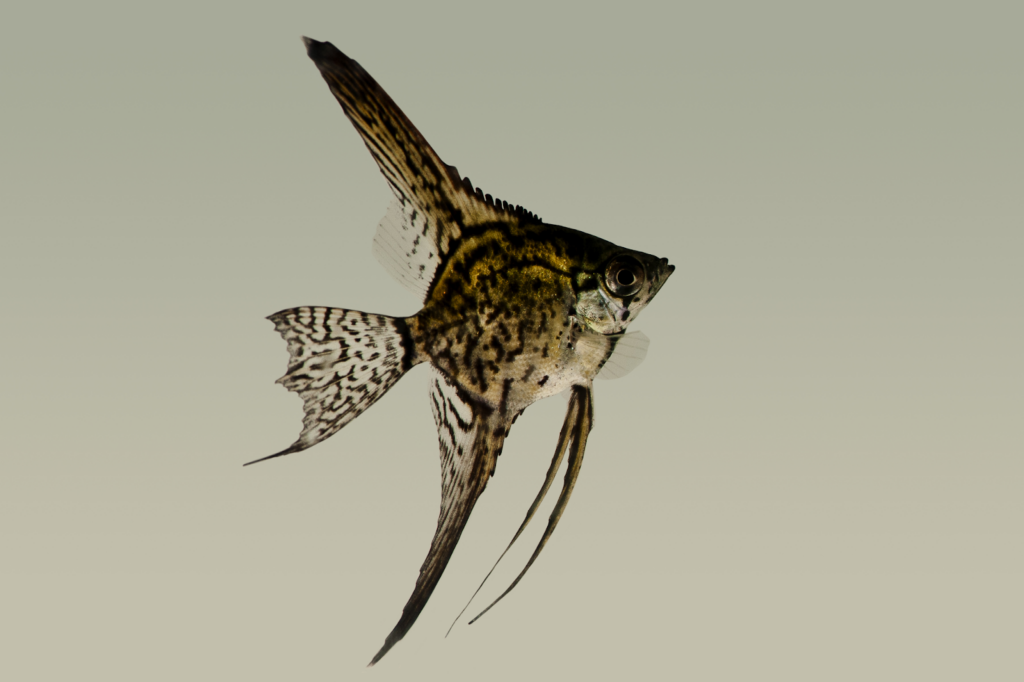
Let’s take a closer look at the features that make this ornamental fish appearance so captivating that the Leopard Angelfish has become a must-have fancy species for modern hobbyists!
Its bold spot patterns immediately stand out because of the unique coloration and the fact that no two leopard angelfish have the same scale design. Another interesting physical trait is its triangular yet sleek body shape and magnificent fin structure.
Its fins are elongated and larger than the average fish species such that sometimes it makes up for half of the Leopard Angelfish’s body, giving it an 8-inch full length. They’re large and flowing, thus giving this species the ability to glide through water effortlessly.
They also have a small mouth with a pointed snout that gives them an interactive face so you can watch their reaction and expressions. They’ll recognize you after a few days of feeding and even seek food when they get comfortable with you.
That also means you can easily tell when your pets feel uncomfortable with their tankmates or the environment. The Leopard’s characteristics, along with other features like easy care requirements, make it prominent among aquarists.
Optimal Care Practices for Leopard Angelfish
Caring for Leopard angelfish requires attention because its scales and finnage are sensitive. You must provide optimal aquarium conditions, focusing on water quality, temperature preferences, and tank conditions to give it the best living environment.
Use the following tips to give your pets optimal care —
Water Quality
Maintain a pH range of 6.5-7.5, with a tolerance of 0.5 and water hardness between 5-15 dGH. Keep the temperature between 78°F-82°F, which is slightly warm but not hot, just like the Amazonian freshwater.
Keep water quality optimal by conducting tests regularly and performing changes when due.
Tank Set up
Use a tall tank at least 18 inches high, which allows for vertical swimming. Add Soft, fine-grained substrates like sand with decor like plants and rocks to create hiding places, and interactive decor is a necessity. Keep reading for more insight on the ideal habitat setup.
Ideal Habitat Setup

Carefully plan your aquarium habitat design to replicate its natural habitat to encourage fish growth by meeting the fish’s physical and behavioral needs. Consider using tropical and Amazonian decor themes to remind your Leopard Angelfish of home.
Aquatic Decoration
You can use live or artificial plants in the tank setup for Angelfish. Some popular options include live plants like Amazon Swords, Java Moss, or Anacharis.
Also, add driftwood and branches for hiding places and territorial markers, but avoid sharp or rough decorations that may harm the fish.
Environmental Needs
Maintain moderate water flow like the slow-moving currents of the South American Amazon River basin.
A pace of 10-15 gallons per minute is decent to meet your angelfish environmental needs, and you can make regular water changes (10-15% weekly) to maintain optimal water quality.
Decoration
Add some life to your tank setup by Incorporating colorful decorations and plants to complement the fish’s natural colors. Substrates are some helpful aquatic decoration tips you should consider when doing this.
Nutritional Requirements and Feeding

Meeting the nutritional needs of Angelfish is straightforward, and the same goes for the Leopard variant. Ensure that meals are rich in protein, carbohydrates, fats and fiber, Vitamins and minerals.
Use this specific guide for feeding Leopard fish:
Nutritional Needs
- Protein: 40-50% of diet. Sources include fish and insects.
- Fat: 10-20% of diet. Sources include fish oil and spirulina.
- Carbohydrates: 20-30% of diet. Sources include plant matter and grains.
- Fiber: 2-5% of diet. Sourced include algae.
Specific Foods
- High-quality commercial flakes or pellets
- Live or frozen foods like bloodworms and brine shrimp
- Vegetables like peas, cucumber, and zucchini
Supplements
Omega-3 fatty acids and vitamin C are necessary for maintaining fish vitality, immune function, and coloration.
Feeding Recommendations
Feed 2-3 times a day, in small quantities. Rotate foods daily to ensure varied nutrient intake. Make sure you pay attention to the angel fish diet specifics; avoid overfeeding and monitor your fish for signs of malnutrition or deficiencies.
For more on feeding your aquatic pets check out The Ultimate Guide to Fish Food: Pros and Cons & Best Choices!
Health Management and Disease Prevention

Now, let’s get into some common illnesses that your Leopard Angelfish may face.
Fin Rot
Fin rot is usually caused by bacterial infection and manifests as the disappearance of fins from the fish.
Treatment: Give fish a salt bath in a separate tank, trim damaged finds, and administer a tetracycline bath
Cloudy Eye
Cloudy Eye disease is caused by internal parasites or poor water quality. It causes loss of sight and white film covering the eye of the fish.
Treatment:
- Seek medical help once you notice any of the symptoms.
- Improve water quality and administer antibacterial or antifungal treatment.
- Administer a salt bath to reduce swelling.
Swim Bladder Disease
Swim bladder disease occurs as a result of overfeeding. It can become deadly because it leads to constipation and strain on the goldfish’s internal organs. Prioritizing a balanced diet is important for your fish health management. See a vet if you notice your fish has a swimming bladder issue.
Treatment: Salt bath, Regular water change, and maintaining a balanced diet will do the trick.
By maintaining a balanced diet and excellent water quality, you can ensure The Leopard Angelfish Health challenges I’ve highlighted above do not affect your fish. Remember, disease prevention always beats cure, so ensure you follow these guidelines to prevent diseases and ensure the long-term health and well-being of your Leopard Angelfish. I recommend consulting a vet if treating angelfish disease at home yields no result.
Breeding Techniques for Leopard Angelfish
Breeding Leopard Angelfish requires careful planning from the breeding pairs to the spawning conditions, fertilization, fry care, and reintegration with adult fish. Consider these tips for Leopard Angelfish breeding:
Selecting Breeding Pairs
Use healthy, mature fish with prominent leopard spotting.
This video has been very helpful in identifying the sex of angelfish, I highly recommend it:
Spawning Conditions
Use a separate tank with a spawning site and enough hiding places and plants for breeding. The spawning site should have a flat surface, whether it’s a wide leaf or a ceramic saucer. Then, ensure the water has the following parameters:
Soft, slightly acidic water (pH 6.5-7.5, dGH 5-15) with temperatures between 82-86°F/28-30°C should be maintained.
Spawning and Fertilization
Introduce the breeding pairs to the tank and condition them with high-quality food and frequent water changes.
Remember that the reproduction methods require external fertilization of the eggs, so find a flat surface or spawning mop for successful laying and eventual fertilization.
Monitor for spawning and remove the adults after spawning. We still need to maintain optimal water conditions as the fry needs them to survive.
Caring for the Fry
Collect the fertilized eggs from the substrate and transfer them to a separate fry tank. Use infusoria or newly hatched brine shrimp as food. Angelfish fry care involves more than just diet; you should strive to maintain water quality and perform regular water changes to ensure fry survival.
Understanding these specific needs helps you in breeding patterned and perfect Leopard Angelfish fry!
Behavioral Insights and Compatibility
Angelfish are typically peaceful tank mates, but they can get aggressive in certain conditions. When considering pairs for community tank compatibility, you must consider their temperament, dietary needs, water condition needs, and size.
The Leopard’s Behavior requires pairing with fish, which are small-medium sized and peaceful dwellers, to avoid predation.
So, look out for non-aggressive, non-fin nipping, a-territorial fish like Neon Tetras, Harlequin Rasboras, Dwarf Gouramis, and Zebra Danios. Remember to use proper angelfish interaction strategies when choosing your tank mates.
Note your pet’s reaction to certain species and remove anyone that causes stress or agitation.
Some more strategies for Integrating Leopard Angelfish into a Community Tank:
- Add Angelfish to the tank last, allowing other fish to establish themselves first.
- Ensure the tank is large enough (at least 20 gallons) with ample swimming space and hiding places.
- Watch for signs of stress, aggression, or fin nipping, and separate fish if necessary.
- Regular water changes, stable temperature, and suitable water parameters promote harmony.
By understanding Leopard Angelfish behavior and following these strategies, managing angelfish behavior and ensuring your tank thrives becomes a breeze.
Conclusion
You’ve made it this far! As parting words, remember these Leopard Angelfish care tips to get the best experience out of your aquarium:
- Water quality should be stellar
- Feed balanced diet
- Monitor the fish closely for signs of disease and treat them as due.
From their Leopard spotting to the silver base color of their body with the beautiful fins, adding this fish to your tank is the secret you’ve been looking for in enriching aquarium life.
If you follow this guide, you’re sure to have ornamental fish expertise that’ll prepare you for the challenges you may face, promising an overall wonderful experience in the end.

